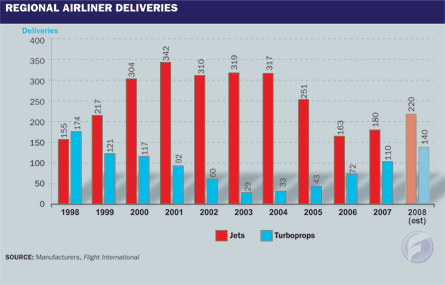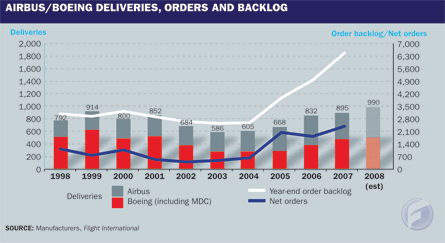After breaking all sales records in 2007, the industry is expecting things to settle down in 2008 - but this is a forecast that was also made at the start of last year and 2006 but has so far failed to become reality.
As 2007 drew to a close, the combined order tally for Airbus and Boeing was approaching 2,400 - putting them comfortably ahead of the record of 2,057 set in 2005. This has pushed the order backlog way beyond 6,000 aircraft with the earliest open delivery slots now out in 2012 for most types.
Sales slowdown
But despite another increase in production rates in 2008 - output across the two mainline airframers is expected to grow to a record 1,000 units in 2008 from around 900 in 2007 - some are convinced sales will have to slow.
Airbus chief operating officer customers John Leahy expects that the 2008 order intake will be "back more towards rate of deliveries, rather than a massive amount of backlog booking", and forecasts "500-odd" sales. "I don't think the backlog can keep growing at anywhere near this rate," he says.
Production numbers were fairly even in 2007 with the two airframers delivering around 450 units each. Although Airbus is expected to remain ahead of its rival for the fifth consecutive year, any lead is likely to have been slashed to a few aircraft. This year has long been the one when Boeing said it would be back on top but the uncertainty over the 787 means that Airbus could retain its lead. Airbus has not disclosed its 2008 output, although based on current production rate increases it is likely to be around 500 aircraft. Boeing had been projecting around 515 to 520 shipments in 2008 - still below its record 620 set in 1999 - but the forecast has been reduced to "480 to 490" because of the impact of the Dreamliner slippage.

Both airframers face key challenges in 2008. Airbus must reinvigorate its Power8 cost-reduction programme as it attempts to deal with the weak dollar. Key to this will implementation of its plan to dispose of non-core factories and the finalising of the A350 XWB's partnership structure.
Airbus has also to build on 2007's successful service entry of the A380 and begin ramping up output towards the 45 aircraft a year it aims to deliver from 2010. Thirteen of the ultra-large aircraft are due for delivery in 2008, with Emirates and Qantas set to join Singapore Airlines in the A380 club over the next 12 months.
Delivery slip
Across the pond, the task of getting the 787 in the air is the most pressing need in Seattle. Boeing has to then hope for a smooth flight test and ramp up to ensure that the impact of the delivery slip is minimised.
While this is going on, the airframer will come under increasing pressure to firm up its plans for the 787-10 stretch as well as formulating a succession plan for the 777. Deliveries of the latest variant of the latter - the 777F - are due to begin to launch operator Air France before the end of 2008.

Boeing will also be pushing hard to establish its 747-8I in the passenger role, having failed to convince British Airways to buy the aircraft after an intense battle with Airbus that saw the A380 victorious. To date, the only customer is Lufthansa and Boeing will want to add to its customer list to enable it to put the BA loss firmly behind it.
A new mainline airliner could join the fold in 2008, if Bombardier is able to secure sufficient business to launch the programme. Northwest Airlines is favourite to sign up as the first customer, and a go-ahead on this stop-start project is expected before year-end, to enable deliveries of the Pratt & Whitney GTF geared turbofan-powered 110-130 seater to begin in 2013.
In the regional sector, the turnaround in the turboprop market that began in 2005 was underlined during 2007, with ATR and Bombardier producing more than 100 ATRs and QSeries between them. This is a remarkable comeback for propeller-driven aircraft - viewed as all but obsolete only a few years ago as the industry clamoured for 50-seat jets - and further strides should see production top 140 aircraft during 2008.
If the rebound continues, Bombardier may take the plunge and firm up plans for the "Q400X" 100-seat stretch of its venerable Dash 8. This would be remarkable given that this turboprop started life in the mid-1980s as a 37-seater in its original Series 100 guise.
ATR is also evaluating the next step for its turboprop family as it ramps up from 44 deliveries in 2007 to 64 in 2008 and 80 annually from 2009. A mid-life update was unveiled for the ATR 42/72 in 2007, and plans for further developments - such as a larger model - could crystallise in 2008.
The E-jet challenge
With Embraer's all-new "E-Jet" large regional jet family now well established, the Brazilian manufacturer is concentrating on establishing its fledgling business aircraft arm. Bombardier has moved to address the challenge from Brazil with its stretched CRJ1000. The first aircraft is due to fly in mid-2008, and enter service the following year.
This should be the year that Russia's civil aerospace industry finally stands up to be counted. The consolidation under the OAK umbrella should begin to have tangible effects, with Sukhoi's all-new Superjet 100 twinjet leading the way. This 95-seater is due to be delivered by the end of 2008 to launch customer Aeroflot, but the flight-test programme has already shown signs of slipping.
Meanwhile China's indigenous regional airliner, the ARJ21-700, is on schedule to fly in March and be delivered to Shandong Airlines in September 2009.
Source: Flight International



















